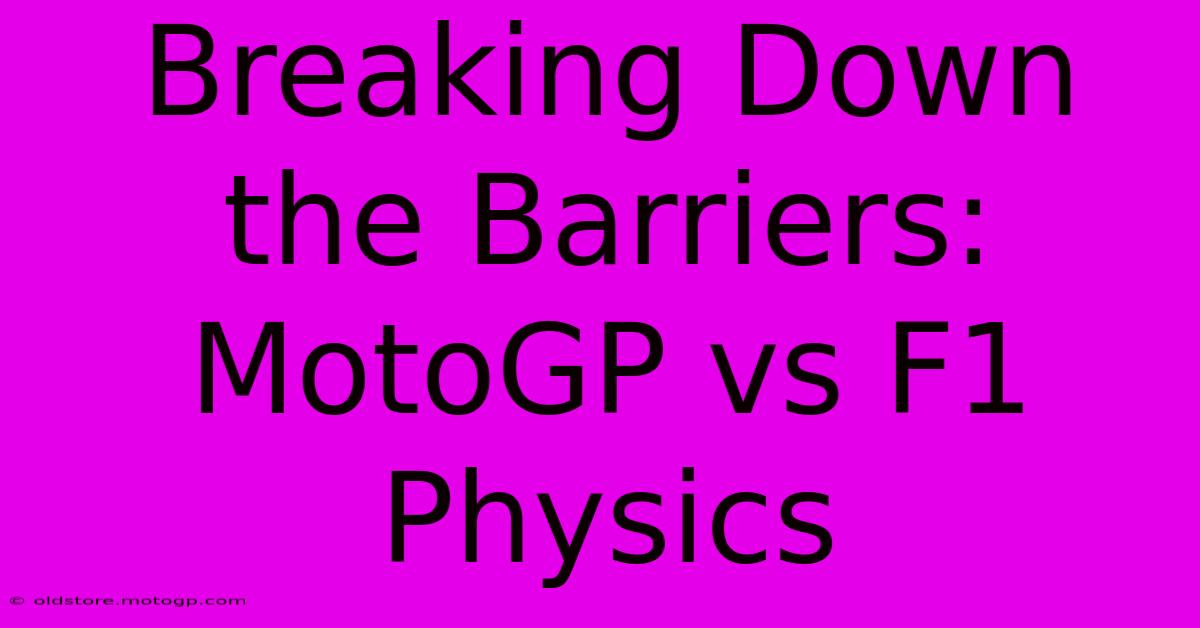Breaking Down The Barriers: MotoGP Vs F1 Physics

Table of Contents
Breaking Down the Barriers: MotoGP vs F1 Physics
The roar of the engines, the breathtaking speeds, the razor-thin margins of victory – both MotoGP and Formula 1 captivate audiences worldwide. But while both are pinnacle motorsport disciplines, the physics governing their performance are strikingly different. This article delves into the key distinctions, exploring how these differences shape the design, strategy, and overall spectacle of each sport.
Two-Wheels vs. Four: The Fundamental Difference
The most obvious difference lies in the number of wheels. This seemingly simple variation has profound implications for everything from tire technology to aerodynamic design. MotoGP bikes, with their two wheels, exhibit significantly higher sensitivity to lean angle, tire grip, and surface irregularities. F1 cars, with their four wheels and wider contact patch, offer greater stability and predictable handling, although they still face challenges of tire management and aerodynamic forces.
Grip and Stability: A Tale of Two Worlds
Grip is paramount in both disciplines, but the nature of grip differs substantially. MotoGP riders rely heavily on lean angle to generate cornering forces, pushing the limits of tire adhesion. A small change in the surface can dramatically alter their trajectory. F1 cars, possessing a much larger contact patch, benefit from greater stability and predictable handling, allowing drivers to push harder into corners with more confidence. This difference translates to dramatically different driving styles and racing lines.
Aerodynamics: Downforce and Drag
While both utilize aerodynamic principles to improve performance, the approaches differ greatly. F1 cars generate substantial downforce, pressing them firmly to the track for high-speed cornering. This is achieved through sophisticated wing designs and carefully sculpted bodywork. MotoGP bikes, due to their size and shape, generate significantly less downforce, relying instead on rider skill and tire grip to navigate corners. The emphasis is on minimizing drag to maximize top speed on straights.
Tire Technology: Specialized Solutions
Tire technology reflects the unique demands of each sport. MotoGP tires are designed for extreme lean angles and rapid changes in direction, requiring exceptional grip and resilience. F1 tires are engineered for high-speed cornering, demanding consistent performance over many laps while managing thermal degradation. The compounds, constructions, and even tire pressures are meticulously tailored to suit the distinct challenges of each competition.
The Human Factor: Skill and Adaptability
The physics involved dictate not only the vehicle design but also the skills required to compete. MotoGP racing demands extraordinary balance, precision, and intuitive feedback from the rider. The bike reacts more dynamically to rider input, requiring constant adjustments to maintain control. F1 driving, while demanding precision, relies more on the car's inherent stability and predictability. While skill is paramount, the car itself plays a more dominant role in determining the overall performance.
The Physics of Spectacle: Why We Watch
The differences in physics translate into distinctly different racing spectacles. The breathtaking lean angles of MotoGP bikes, the close proximity of riders battling for position, and the high level of rider skill create a visceral and exciting display. F1, with its high speeds, strategic pit stops, and complex aerodynamic battles, offers a distinct form of intensity. Both, however, rely on the fascinating interplay of physics, engineering, and human skill to create captivating races.
Conclusion: A Celebration of Engineering and Human Skill
MotoGP and Formula 1, while both belonging to the realm of high-speed motorsport, are governed by significantly different physical principles. Understanding these differences sheds light on the distinct engineering challenges, racing strategies, and overall spectacle of each sport. Ultimately, both offer a captivating blend of human skill and technological innovation, showcasing the incredible potential of both two and four-wheeled machines.

Thank you for visiting our website wich cover about Breaking Down The Barriers: MotoGP Vs F1 Physics. We hope the information provided has been useful to you. Feel free to contact us if you have any questions or need further assistance. See you next time and dont miss to bookmark.
Featured Posts
-
Moto Gp Vs F1 The Ultimate Guide To Motorsport
Feb 20, 2025
-
Racing On Tv Today Your Search Ends Here
Feb 20, 2025
-
Cota Concert Schedule Dont Miss A Beat
Feb 20, 2025
-
The Sting Formula 1 News And Updates
Feb 20, 2025
-
Moto Gp Austin Hot Dates For A Hotter Race
Feb 20, 2025
